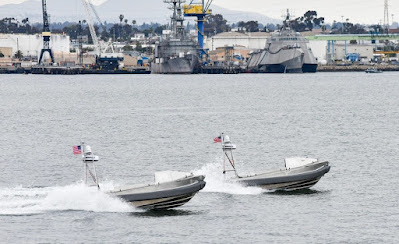I just read yet another article extolling the wonders of
unmanned surface vessels for logistics and/or attack.[1][3] This one was singing the praises of the
Leidos Sea Specter slow, low profile boat which Leidos claims can carry a 2-5
ton payload for 1000-2200 nm at 8 kts in sea state 3.[2] The manufacturer’s original concept was for this craft to be
used as a logistics delivery platform. A
recent article suggested it could be used to attack Chinese carrier or surface
groups using a containerized torpedo.
Let's consider a couple of important aspects to this concept.
Speed – This
craft, like most unmanned craft, is appallingly slow; it can’t get anywhere useful in any
tactically relevant time frame. While
the manufacturer claims the craft can sail from Guam to any point in the first
island chain on a single tank of gas, it would, as a relevant example, take 5+
days, best case, to make a 1000 nm journey.
This demonstrates the idiotic nature of a combat use for this
craft. Say a Chinese surface group was
spotted transiting past an island, it would take around a week for the craft to
carry its single containerized torpedo to that point. Of course, the target group would be long
gone. People are making this stuff up
without thinking it through.
Payload – The
payload is very small with severe volumetric limitations which will reduce the
effective payload substantially. The cargo
area is limited in volumetric size to a maximum payload storage area of 29’ x
4’ x 4’ which, essentially, means just small boxes as opposed to any sizable
equipment.
After seeing the tiny cargo area in a manufacturer’s video, it is obvious that the claimed payload of 2-5 tons would only be for bricks stacked in the area with no space. Any realistic cargo, with packaging and space will be far less. One ton might be optimistic.
This is far too small a payload to be logistically
significant for any but, perhaps, a lone coastwatcher on an island
mountain. For example, an infantry
division in combat consumes some 1000 tons of various supplies per day and
that’s probably unrealistically low! An
armored division uses some 600,000 gal (2000 tons) of fuel per day in combat and,
again, that’s probably ridiculously optimistic.
If someone thinks we’re going to resupply Guam or some far
flung, hidden Marine missile shooting outpost using these tiny boats, they’re
sadly mistaken.
After seeing the tiny cargo area in a manufacturer’s video, it is obvious that the claimed payload of 2-5 tons would only be for bricks stacked in the area with no space. Any realistic cargo, with packaging and space will be far less. One ton might be optimistic.
 |
| Leidos Sea Scepter |
https://www.navalnews.com/naval-news/2025/04/u-s-marine-corps-trials-unmanned-logistics-concepts-in-the-indo-pacific/
https://www.navalnews.com/naval-news/2025/07/u-s-navy-pairs-heavyweight-torpedo-with-usv-in-a-new-program-effort/
